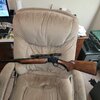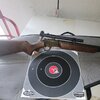I expect most shooting folk know that the .22 Hornet was born at Springfield Armory back in the 1920's. The "War To End Wars" had ended a few years earlier so there were no pressing emergencys at Springfield, now under the command of Townsend Whelen. So with some extra time on their hands, Whelen and his shooting pals set about doing what they liked best: shooting and trying out their own ideas about rifles and ballistics. At that time Springfield Armory must have been Paradice for gun-nuts like Whelen because not only did they have all the free guns and ammo they could shoot but well trained gun craftsmen at their beck and call plus a fully equipped machine shop under the direction of James Howe, a genius at designing and making tools like chambering reamers. One of their many projects was installing some life into the aged .22 WCF, a black powder cartridge that got up to about 1500fps with a lead bullet. By protecting the lead bullet with a copper jacket, and replacing black powder with smokeless pistol powder they added 1000 fps to the tired old .22 WCF, doubling its range and flattening its trajectory. And as for rifles to shoot their new cartridge they needed look no further than the bolt action .22 rimfire rifles they had begun making in 1922, which could be converted to centerfire and rechambered by a machine shop genius like James Howe. (Those reborn CF rifles were built with RF dimension barrels, which is why the bore size of .22 Hornets came to be slightly smaller than that of later .22 Cal centerfires.) Howe was to later leave Springfield and become the co-founder of Griffin & Howe, an uppity New York city custom gunsmithing firm who, along with other custom services converted M-22's to .22 Hornets the way they had done it back at Springfield. They also remade the magazine to feed the Hornet and dressing it all up with their destinctly classic stock. Added features included reshaping the bolt handle and installing a side swing safety like Winchester's as on this rifle. Accuracy of the Hornet was enhanced by higher magnification target style scopes that appeared in the 1930's, like the vintage 8X Unertl on this G&H rifle, and ballistic performance boosted by the K-Hornet chambering of this rifle. Sorry this got so long, but enjoy the pics anyway.
View attachment 1121968 View attachment 1121969 View attachment 1121970 View attachment 1121971








